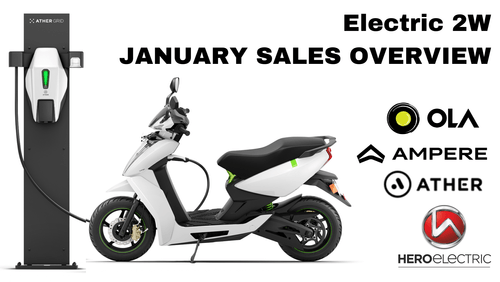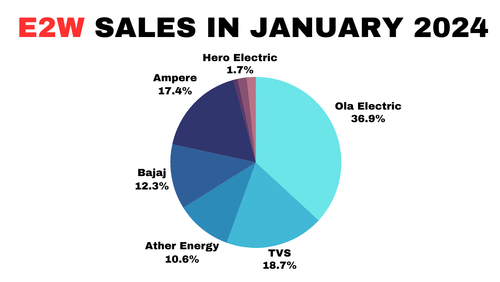Ad
Ad
Electric Two-Wheeler Sales in January 2024: Ola, TVS, Bajaj, & Ampere Emerges as Growth Leader
Stay informed about the growth leaders in electric two-wheeler sales for January 2024, featuring Ola, TVS, Bajaj, and Ampere.

Key Highlights:
- Sales of January 2024 saw a massive YoY growth. Key players were Ola, Bajaj, Ampere and TVS
- The MoM sales of January 2024 reflects progressive growth rate.
In the ever-evolving landscape of the Indian electric two-wheeler market, February 2024 witnessed notable shifts in sales figures among key manufacturers. Analyzing the data from both month-over-month (MoM) and year-over-year (YoY) perspectives provides crucial insights into the industry's dynamics, market trends, and individual company performances.
Ad
Ad

Electric two-wheeler MoM Analysis:
Manufacturer | January 2024 | December 2023 | Difference | Growth % MoM |
32,160 | 30,219 | 1941 | 6.03 | |
16,276 | 11,232 | -5,044 | 30.99 | |
9,209 | 6,481 | -2,728 | 29.62 | |
10,742 | 10,323 | -419 | 3.90 | |
15,181 | 3346 | 11835 | 77.95 | |
683 | 965 | 282 | -29.22 | |
1,488 | 552 | -936 | 169.5 | |
1485 | 1,214 | -271 | 22.32 |
The electric vehicle (EV) market in India has witnessed significant growth in recent years, driven by factors such as government incentives, environmental concerns, and technological advancements. In this article, we will analyze the performance of prominent EV manufacturers in January 2024 compared to December 2023, focusing on key metrics such as production numbers and month-on-month (MoM) growth rates.
Ola Electric
Ola Electric, one of the leading players in the Indian EV market, witnessed a production increase from 30,219 units in December 2023 to 32,160 units in January 2024, marking a MoM growth rate of 6.03%. This growth reflects the company's continued efforts to expand its market presence and meet the growing demand for electric vehicles.
TVS
TVS, while experiencing a production decrease from 11,232 units to 16,276 units (-5,044 units), recorded a substantial MoM growth rate of 30.99%. Despite the decline in absolute numbers, this surge in growth indicates a potential rebound for TVS in the EV segment, possibly attributed to strategic initiatives or market dynamics.
Ather Energy
Similarly, Ather Energy reported a production decrease from 6,481 units to 9,209 units (-2,728 units) but achieved a noteworthy MoM growth rate of 29.62%. This suggests resilience in the face of challenges, with Ather Energy making strides towards its long-term objectives despite short-term setbacks.
Bajaj
Bajaj, with a marginal production decline from 10,323 units to 10,742 units (-419 units), saw a MoM growth rate of 3.90%. While the decrease in production is minimal, Bajaj's ability to maintain positive growth reflects its stability in the EV market.
Ampere
Ampere emerged as a standout performer, witnessing a significant production surge from 3,346 units to 15,181 units (11,835 units), translating to an impressive MoM growth rate of 77.95%. This remarkable growth underscores Ampere's strong market position and consumer demand for its products.
Okinawa Electric, Hero Electric, and BGAUSS
In contrast, Okinawa Electric, Hero Electric, and BGAUSS experienced production declines with varying degrees of severity. Okinawa Electric recorded a modest decrease of 282 units (-29.22% growth rate), while Hero Electric saw a substantial decline of 936 units (169.5% growth rate). BGAUSS reported a decrease of 271 units, coupled with a growth rate of 22.32%. These trends highlight the challenges faced by certain manufacturers in maintaining growth momentum amidst competitive pressures and market dynamics.
Electric two-wheeler YoY Analysis:
Manufacturer | January 2024 | January 2023 | Difference | Growth % YoY |
Ola Electric | 32,160 | 18,245 | 13915 | 76.26 |
TVS | 16,276 | 12,169 | 4107 | 33.74 |
Ather Energy | 9,209 | 12,149 | -2940 | -24.19 |
Bajaj | 10,742 | 2,629 | 8113 | 308.59 |
Ampere | 15,181 | 4120 | 11061 | 268.47 |
Okinawa Electric | 683 | 4,408 | -3725 | -84.5 |
Hero Electric | 1,488 | 157 | 1331 | 847.7 |
BGAUSS | 1485 | 716 | 769 | 107.4 |
The electric two-wheeler market has witnessed significant growth and transformation over the past year, driven by factors such as technological advancements, increasing environmental awareness, and government incentives. In this article, we delve into the performance of leading manufacturers in January 2024 compared to January 2023, analyzing their sales figures and growth rates to gain insights into the evolving landscape of electric mobility.
Ola Electric
Ola Electric emerges as a frontrunner in the market, with a remarkable year-on-year growth of 76.26%. This substantial increase from 18,245 units in January 2023 to 32,160 units in January 2024 underscores the company's successful strategies in product innovation, market penetration, and customer engagement.
TVS
TVS demonstrates a commendable growth rate of 33.74%, with sales climbing from 12,169 units to 16,276 units. The company's consistent performance reflects its ability to adapt to changing consumer preferences and leverage its brand reputation to expand its market share.
Ather Energy
Ather Energy, despite a decrease in sales volume from 12,149 units to 9,209 units, experiences a decline of 24.19% year-on-year. This downturn raises questions about the company's market positioning, product competitiveness, and the effectiveness of its growth strategies.
Bajaj
Bajaj emerges as a standout performer, witnessing an extraordinary growth rate of 308.59%. Sales surge from 2,629 units to 10,742 units, indicating the successful execution of expansion plans, strategic partnerships, and product diversification initiatives.
Ampere
Ampere records a substantial growth rate of 268.47%, with sales escalating from 4,120 units to 15,181 units. The company's strong performance can be attributed to its focus on affordability, quality, and distribution network expansion, resonating well with the evolving market dynamics.
Okinawa Electric
Okinawa Electric faces a significant decline of 84.5% in year-on-year sales, plummeting from 4,408 units to 683 units. This downturn emphasizes the challenges the company encounters in maintaining competitiveness amidst intensifying competition and changing consumer preferences.
Hero Electric
Hero Electric showcases an exceptional growth rate of 847.7%, with sales surging from 157 units to 1,488 units. The company's concerted efforts towards product innovation, brand building, and market expansion contribute to its remarkable performance in the electric two-wheeler segment.
BGAUSS
BGAUSS demonstrates a noteworthy growth rate of 107.4%, with sales increasing from 716 units to 1,485 units. The company's focus on delivering value-driven solutions, customer-centric approach, and strategic marketing initiatives fuel its growth trajectory in the competitive market landscape.
CarBike360 Says
Overall, the electric vehicle industry in India continues to witness dynamic shifts in production numbers and growth rates among key manufacturers. While some players demonstrate resilience and strong growth trajectories, others face challenges that require strategic adaptations.
Analyzing sales figures and growth rates provides valuable insights into the performance of key players, enabling stakeholders to formulate informed strategies and navigate the dynamic landscape of electric mobility effectively.
Also Read: Ola Electric's S1 Pro Receives Second Product Certification Under PLI Scheme
More News
Honda City Facelift Spotted Testing Ahead of Expected 2026 Launch
The Honda City Facelift has been spotted testing in full camouflage, hinting at subtle design updates, minor interior revisions, and the continuation of existing petrol and hybrid powertrain options.
20-Dec-2025 07:50 AM
Read Full NewsHonda City Facelift Spotted Testing Ahead of Expected 2026 Launch
The Honda City Facelift has been spotted testing in full camouflage, hinting at subtle design updates, minor interior revisions, and the continuation of existing petrol and hybrid powertrain options.
20-Dec-2025 07:50 AM
Read Full News2026 Audi Q3 Third-Generation Spied Testing In India Ahead Of Its Launch
Audi's next-gen Q3, spied on Mumbai streets reveals bold styling and a digital cockpit ahead of the 2026 India launch, replacing the current model with enhanced performance and features.
20-Dec-2025 06:24 AM
Read Full News2026 Audi Q3 Third-Generation Spied Testing In India Ahead Of Its Launch
Audi's next-gen Q3, spied on Mumbai streets reveals bold styling and a digital cockpit ahead of the 2026 India launch, replacing the current model with enhanced performance and features.
20-Dec-2025 06:24 AM
Read Full NewsDucati XDiavel V4 Teases Ahead of Its Official Debut in India, Bookings Now Open
Ducati ignites buzz with XDiavel V4 teaser. The bike powers a 1,158 cc V4 engine, has cruiser ergonomics, and has premium features set for a January 2026 India debut. Bookings are open now.
19-Dec-2025 02:01 PM
Read Full NewsDucati XDiavel V4 Teases Ahead of Its Official Debut in India, Bookings Now Open
Ducati ignites buzz with XDiavel V4 teaser. The bike powers a 1,158 cc V4 engine, has cruiser ergonomics, and has premium features set for a January 2026 India debut. Bookings are open now.
19-Dec-2025 02:01 PM
Read Full NewsUpcoming Honda Car Launching in India in 2026
Honda accelerates into 2026 with 6 key launches blending compact SUVs, facelifts, and premium hybrids for Indian roads that promise tech, efficiency, and market outlook.
19-Dec-2025 11:07 AM
Read Full NewsUpcoming Honda Car Launching in India in 2026
Honda accelerates into 2026 with 6 key launches blending compact SUVs, facelifts, and premium hybrids for Indian roads that promise tech, efficiency, and market outlook.
19-Dec-2025 11:07 AM
Read Full NewsMaruti Suzuki Wagon R Achieved 35 Lakh Production Unit Milestone
The iconic Maruti WagonR achieves a 35 lakh production milestone, cementing its status as India's favorite hatchback with unmatched reliability and efficiency.
19-Dec-2025 07:09 AM
Read Full NewsMaruti Suzuki Wagon R Achieved 35 Lakh Production Unit Milestone
The iconic Maruti WagonR achieves a 35 lakh production milestone, cementing its status as India's favorite hatchback with unmatched reliability and efficiency.
19-Dec-2025 07:09 AM
Read Full NewsKTM 160 Duke Now Offers A 5-inch TFT Display At Rs 1.78 Lakh
The KTM 160 Duke gets a premium upgrade with a 5-inch color TFT display, bonded glass, turn-by-turn navigation and Bluetooth connectivity, priced at Rs 1,78,536 ex-showroom Delhi.
19-Dec-2025 05:26 AM
Read Full NewsKTM 160 Duke Now Offers A 5-inch TFT Display At Rs 1.78 Lakh
The KTM 160 Duke gets a premium upgrade with a 5-inch color TFT display, bonded glass, turn-by-turn navigation and Bluetooth connectivity, priced at Rs 1,78,536 ex-showroom Delhi.
19-Dec-2025 05:26 AM
Read Full NewsAd
Ad
Cars In India
MG Hector Plus
₹ 17.29 - 19.49 Lakh
MINI Cooper S Convertible
₹ 58.50 Lakh
Mahindra XEV 9S
₹ 19.95 - 29.45 Lakh
Tata Sierra
₹ 11.49 - 21.29 Lakh
Porsche Cayenne EV
₹ 1.76 - 2.26 Cr
Kia New Seltos
₹ 10.99 - 20.80 Lakh
Mahindra 7XO
₹ 14.00 - 26.00 Lakh
Maruti e Vitara
₹ 20.00 - 25.00 Lakh
Nissan Gravite
₹ 6.20 - 9.00 Lakh
Hyundai Ioniq 5 Facelift
₹ 36.37 - 46.36 Lakh
Ad
Ad
Ad
